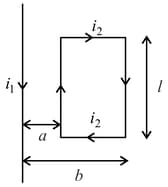Embibe Experts Solutions for Chapter: Magnetic Effect of Current and Magnetism, Exercise 1: Exercise 1
Embibe Experts Physics Solutions for Exercise - Embibe Experts Solutions for Chapter: Magnetic Effect of Current and Magnetism, Exercise 1: Exercise 1
Attempt the practice questions on Chapter 19: Magnetic Effect of Current and Magnetism, Exercise 1: Exercise 1 with hints and solutions to strengthen your understanding. Physics Crash Course NDA & NA EE solutions are prepared by Experienced Embibe Experts.
Questions from Embibe Experts Solutions for Chapter: Magnetic Effect of Current and Magnetism, Exercise 1: Exercise 1 with Hints & Solutions
In a certain region of space, electric field and magnetic field are perpendicular to each other and an electron enters in region perpendicular to the direction of and both and moves undeflected. Then velocity of electron is
Which particles will have minimum frequency of revolution when projected with the same velocity perpendicular to a magnetic field?
A proton of energy is moving in a circular path in uniform magnetic field. The energy of an -particle moving in the same magnetic field and along the same path will be
A current carrying square loop is placed near a straight infinitely long current carrying wire as shown in figure. The torque acting on the loop is

Two parallel conducting wires of equal lengths placed distance apart carry currents and respectively in opposite directions. The resultant magnetic field at the midpoint of both the wires is ( permeability of free space.)
A very long straight wire of radius carries current . Intensity of magnetic field at a point lying at a perpendicular distance from the axis is _____ .
A bar magnet of magnetic moment is placed in a uniform magnetic induction If each pole of a magnet experiences a force of then the magnetic length of the magnet is
A magnetic dipole of moment is placed in the magnetic field . It is free to rotate about an axis about which its moment of inertia is . It is displaced by a small angle at time and released. The dipole undergoes simple harmonic motion with angular frequency . Its potential energy at time is : (Assume if )
